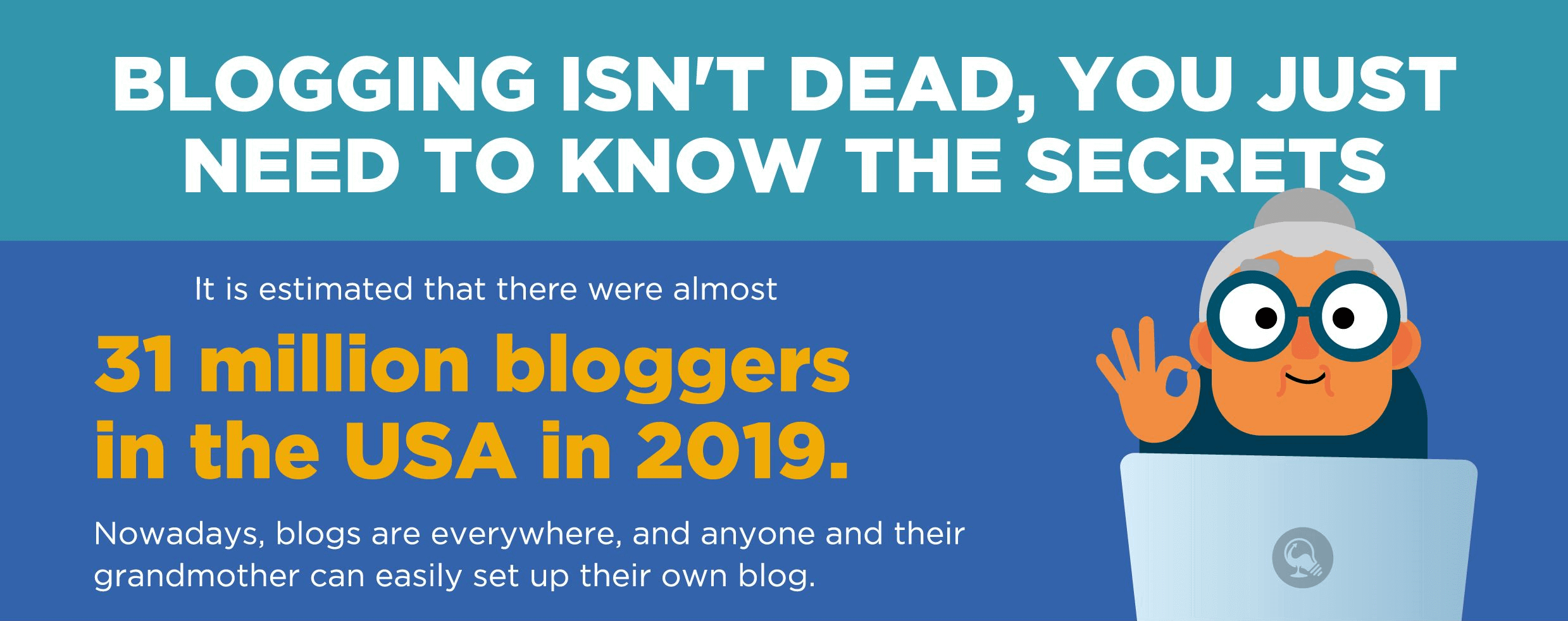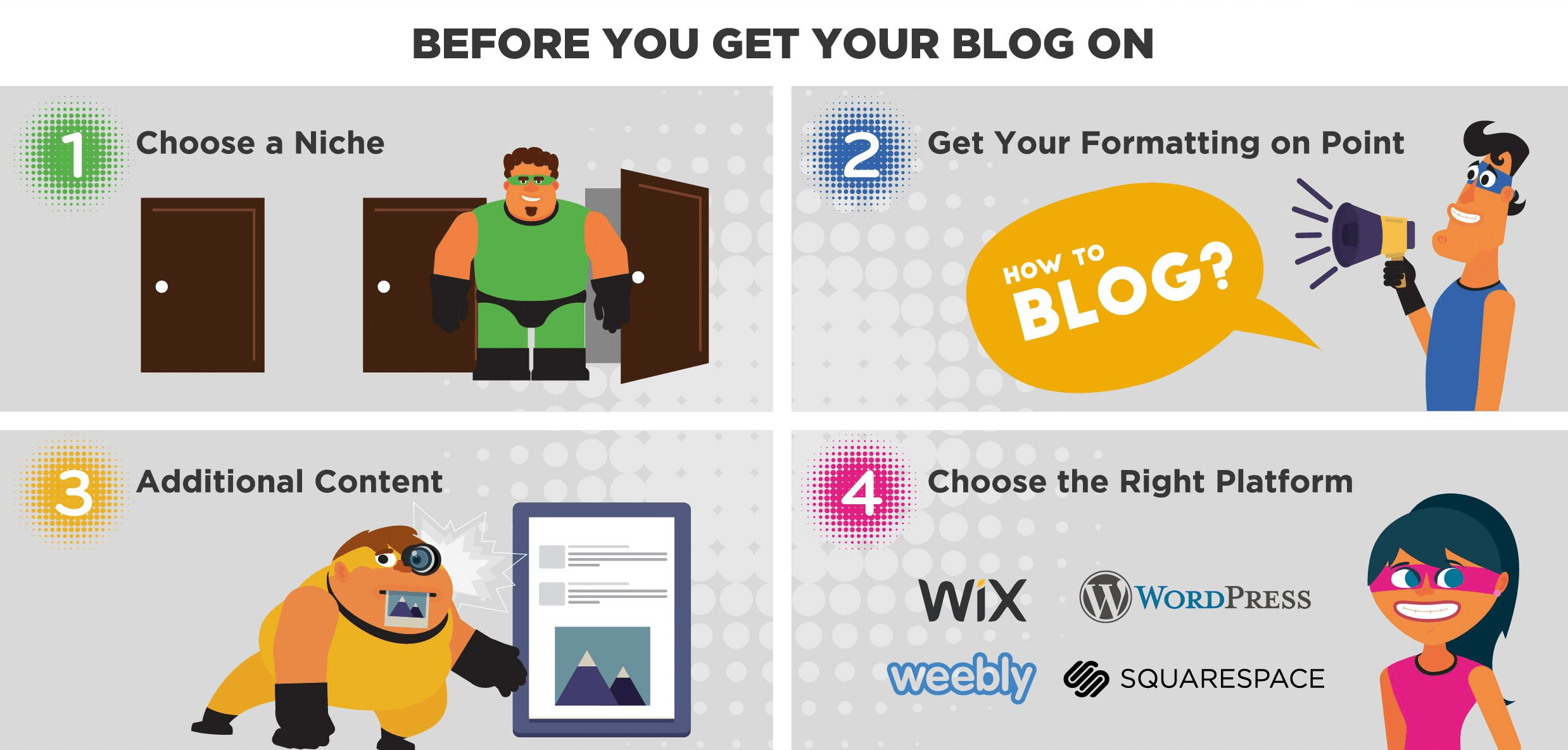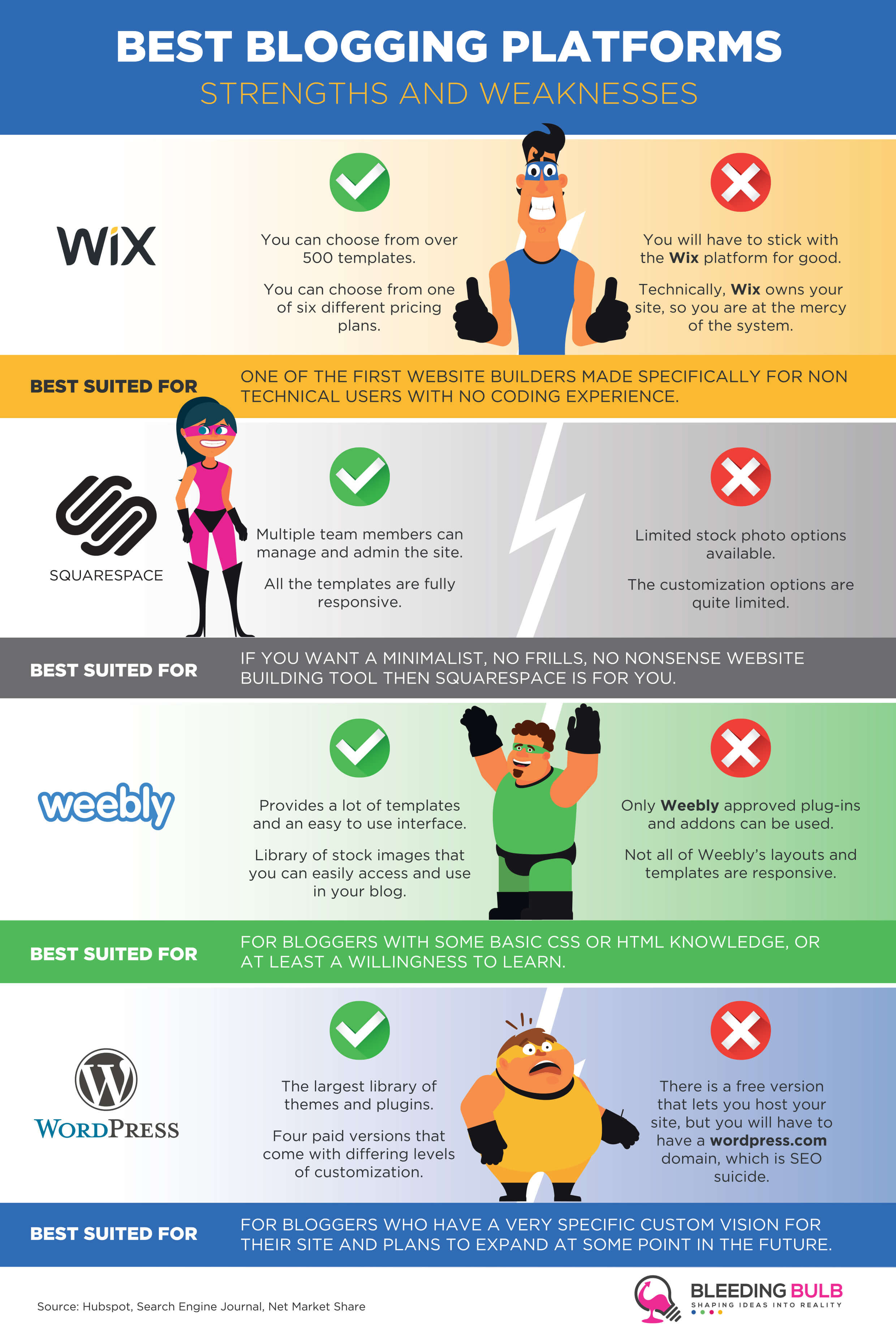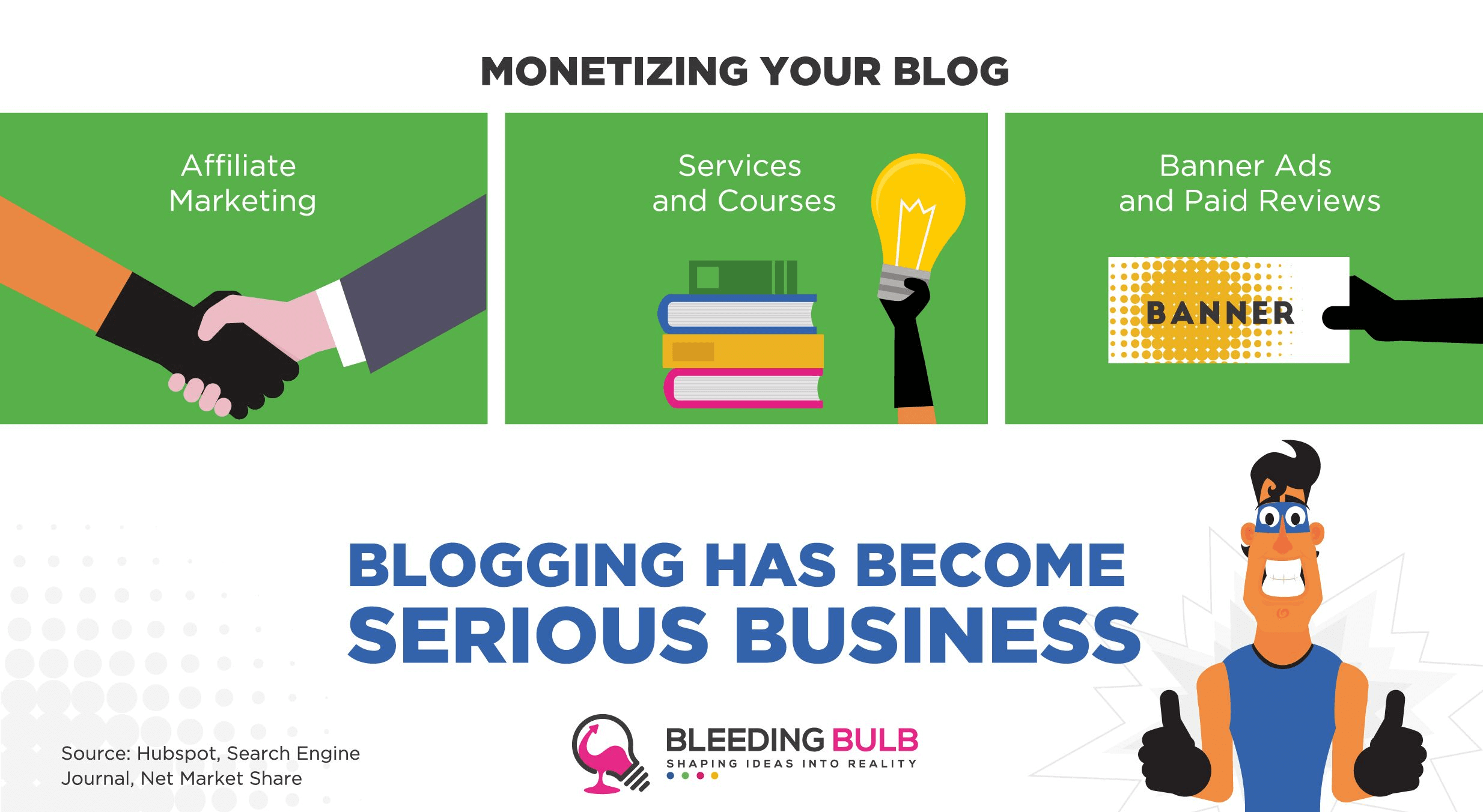Introduction
A lot has changed in the world of blogging since the fist blog hit the net in the early nineties. Originally called weblogs, blogs were once not much more than logs of what you came across while browsing the web. They were, if you will, a type of personal homepage to collect your thoughts. Nowadays, blogs are everywhere, and anyone and their grandmother can easily set up their own blog. To get statistical, it is estimated that there were almost 31 million bloggers in the USA in 2019.

On the one hand, it is inspiring that so many people can express their opinions and views and share their talents on the net. The downside is that it has never been harder to make it in the blogosphere with so much fierce competition and sheer volume of content being constantly produced. Only a select few can make a living from blogging, and this does not happen by accident or overnight. Read on if you want to stand a chance of making it big in the world of blogging.
Before you Get Your Blog On
The boundaries for entry to the blogosphere, as we have already mentioned, are almost non existent. All you need is an internet connection and a device to write on. Many are lured into blogging by success stories of bloggers making insane amounts of money from their blogs, and expect that the same will happen for them. This is a certain formula for disappointment.
As many successful bloggers will tell you, the road to the top is anything but straightforward or comfortable. Contrary to popular belief, if you build it they will not come. If you plan on having a high traffic, successful blog and bringing in the big bucks you will need to approach your blog as a full time serious business. In other words, you should approach blogging as your full time job. If you do not take it seriously, chances are no one else will either.
There is a high level of dedication that is required for building and maintaining a successful blog, and you need to be constantly productive if you want to reap the rewards down the line. Most bloggers do not earn a single dime from their blog for the first few months, and this is totally normal. Just because you have started blogging does not mean you can quit your day job. Not yet anyway.
Consistent output is often more of a deciding factor in your success than the quality of your writing or other blog content. You should post new content at least once a week, as posting less frequently will make it more difficult for you to establish a regular reader base. Once you get some all important regular readers, they will look forward to new content on your blog, and you will need to deliver what they want, no excuses and no sick days.

Another reason for consistent posting is that it is sound SEO practice. The more posts you produce, the more inbound linking and indexing opportunities you will have. This in no way means that you should sacrifice the quality of your content, as google will quickly pick up on low quality material as well as content that is a lazy spin off of other material that is available online. Both your output and quality need to be consistently high for healthy growth and income.
Last but not least, your competition will ultimately dictate your optimal posting frequency. A large part of blogging is keeping up to date with what others are doing, especially if they are in your niche. If there is a successful blog that deals with similar subjects as yours but has a bigger following, you will need to try and one up the competition by posting more often than them and on subjects that they might have neglected.
Investing in quality content might be time and resource consuming but it will pay dividends in the long run. If your content is consistently on point, then publishing new content often will leave you open to more opportunities for exposure and revenue. The more blog posts you have, the more indexed pages you will have with google and other search engines. With more volume, you are also much more likely to achieve the much coveted but elusive viral post, and you are more likely to keep your core readership satisfied and engaged.
Choose a Niche
The very first step in your journey to blogging greatness is to choose a niche that is just right for you. If you are just getting started, a niche blog that directly relates to a narrow topic is a great way to attract readers and start monetizing. Make sure that your chosen niche is something you are passionate and knowledgeable about. You will spend a lot of time and energy writing about it, and this will be a whole lot easier if it is something you enjoy reading about and researching.
Readers can detect passion and genuine enthusiasm, so sticking to what you know is a surefire way of gaining a dedicated following early on. Although you definitely can incorporate broader topics and stray from your core theme, your readers will return to your blog for your unique insight on your niche. Straying too far from your area of expertise might drive your traffic elsewhere.
Not all niches are created equal, and you should choose yours carefully. Try to think long term, and consider how much interest there will be in that area down the line. Trend niches are a dime a dozen, and you should steer well clear of them. Avoid getting bogged down in topics that do not have staying power, such as fads and things that are popular today but will most likely disappear in future. Blogging about a TV show is a great example of a bad idea. The interest can be great while the show is running, but when it gets cancelled all you will be left with is a fade out in traffic.
Get Your Formatting on Point
Let’s face it, the vast majority of internet users do not really read; they skim. Gone are the days of reading newspapers and magazines from cover to cover in great detail. Reader’s minds and habits have adapted to our data saturated, instant access digital climate, and if they do not get the information they need fast, they instantly move on. The skimmability of your content is arguably more important than the content itself, and as a result great writers can find themselves being successful at blogging if they do not adapt to the shortened attention span of the online reader. People have far less patience and far more distractions when reading on a digital device, and your format needs to be optimized for this.
The very first thing you need to do is come up with an eye catching headline, as this is your first and quite possibly only opportunity to grab your reader’s attention. How interested would you be in reading this article if it was called “How to blog”? My guess is not very. In addition to being catchy, your title also needs to include SEO keywords and describe the topic you are writing about. Being too clickbaity is a surefire way of losing readers. If you need some inspiration, here is a list of 50 eye catching blog title ideas.
Now that you have a kick ass title, your introduction needs to be well thought out and to the point. This is not just common sense, it is extremely important for SEO reasons as well. The first few lines of your article are what will be shown to readers when your blog post comes up in a google search. Think about what type of introduction would be most enticing to your target audience and write accordingly.
Keep your sentences short and actionable, and avoid keyword stuffing and fluff. The same applies for paragraph length; more than six words per paragraph is blog format suicide. Headings and subheadings are an extremely valuable blog formatting tool, and are key to clue your readers in to what your post is about. Use them to break up large parts of your text, but be wary of the fact that too many subheadings can overwhelm your post.
Reader’s eyes can get tired when reading on a screen, so emphasising important words or phrases helps focus attention and visually break up the article. The easiest and most effective way to achieve this is to bold key words and sentences. It will help skimmers easily and quickly find your most important points. Italics may seem more elegant but are more difficult to pick out at a glance. CAPITAL LETTERS SHOULD BE AVOIDED, as they come off as unnecessarily loud, pushy and annoying. Just look at them. The same applies to superfluous exclamation marks.
We have mentioned the importance of a great title, but how you end your post is just as important. The worst thing you could do is write an article without a conclusion. You have probably found yourself in a situation where you scroll to the bottom of an article before even reading it, and I catch myself doing the same thing. Reading the conclusion first gives you an idea of weather the whole text is even worth reading. Write your conclusion first, and label it conclusion. Nothing beats clarity.
Additional Content
If you think blogs are just blocks of text, you are woefully mistaken. A successful blogger takes advantage of any type of content they can get their hands on, and tries to make sure their posts can turn heads. The most common ways of doing this are by using interesting and relevant images to support what you are saying and visually draw the reader in to your article.
While images, headings and user friendly skimmable formatting are a staple of the blog, there is so much more you can include in your blog to attract attention and keep your reader interested and engaged. For example, linking relevant videos in your posts will not only give your audience a whole new format, but will also keep them on your page for a longer time, which can result in more revenue for you.
Infographics are a great addition to any blog, as they are the very epitome of skimmability. A great infographic gives an instant visual representation of what you are writing about. They help to break down and categorize information that might otherwise be difficult to digest. Custom infographics that have been developed specifically for your post also give you an air of credibility and assure you reader of your commitment and expertise in the subject you are writing about.
Readers are not only looking for information or a solution to a problem, but they increasingly want to have a conversation and voice their own opinions. You can make your readers feel more involved by giving them this opportunity. The easiest way to achieve this is by embedding social media into your posts, such as “click to tweet buttons”. Lists and tables are also a valuable addition to your blog, as is anything that stands out and adds value.
Choose the Right Platform
So by now you know what to expect from blogging, have a niche and know how to format and enrich your content. The next step is to actually build your website, and this can be overwhelming for many a budding blogger. Blogging platforms are a dime a dozen, which is both a blessing and a curse.
You do not need to have any design or coding experience, as they are all intuitive and more or less drag-and-drop based. There is definitely a platform out there that matches your needs, and we have chosen four of the most popular ones, in no particular order: WordPress, Squarespace, Weebly and Wix. The following is a breakdown of their strengths and weaknesses. Which one you decide on will ultimately depend on your budget, vision, needs and personal preference. All of them offer a free trial period, so you can try each one out before reaching for your wallet.
Wix
Wix was one of the first website builders that geared specifically to non technical users with no coding experience. With Wix, you can choose from over 500 templates which are either free or payed and designed to meet different niche and industry needs. Wix has a free trial option that allows you to try out before you buy, and with over 110 million websites hosted on wix, it is one of the most popular website builders out there.
Depending on your budget, needs and preferences, you can choose from one of six different pricing plans. The more expensive plans, the Combo Plan and above, come with a free registered domain, while less expensive plans require you to connect a pre purchased plan. Premium plans have advanced analytics tools that can provide valuable insight about your website traffic and visitor activities. Wix is geared to the complete novice, and requires absolutely no technical know how, just your basic drag-and-drop.
The glaring downside of using Wix is that when you build your site and domain, you will have to stick with the Wix platform for good. Technically, you Wix owns your site, and you are indefinitely at the mercy of the system as it is very hard to switch to another platform down the line. If something adverse should happen to the servers or the company, you website and business might take a devastating hit.
Squarespace
If you want a minimalist, no frills, no nonsense website building tool then Squarespace is for you. It has one of the most user-friendly minimalist interfaces on the market, lets you make changes fast and immediately publishes the changes to your site. Another selling point for Squarespace is that it allows multiple team members to manage and admin the site.
When it comes to blog templates, Squarespace has some of the best free ones you can find online. You can buy Squarespace templates on sites like Creative Market and Etsy, with new original templates being created all the time. There are also thousands of free to download templates. All the templates are fully responsive, meaning that your blog will look great regardless of what device it is being displayed on.
While many hosts require you to manually update applications and plugins as they change, Squarespace provides automatic platform updates which saves you a lot of time and maintenance. Another valuable feature is the preview option which lets you see what your content will look like on the live site without actually publishing it. This lets you make changes if you do not like how something looks without your site suffering any downtime.
Some users might find this platform difficult to use because its templates rely quite heavily on images and content that you will have to provide yourself, as there are just a few stock photo options available. If you do not want to spend a lot of time and money on media other than content, this might be a dealbreaker for you. Additionally, you might be disappointed if you have a very specific design vision for your blog, as the customization options are quite limited.

Weebly
Weebly is relatively inexpensive and provides a lot of templates and an easy to use interface. It offers a bunch of very functional themes that can get your blog up and running in just a few clicks. Their layouts are clean and simple, and Weebly even offers an inbuilt library of stock images that you can easily access and use in your blog. Weebly also offers discounted rates if you sign up for a year or more.
Weebly might be more suited for bloggers with some basic CSS or HTML knowledge, or at least a willingness to learn. The themes can only be customized a little bit, with more advanced customisation requiring a certain degree of web development skills. Weebly limits your access to any additional features that are produced by other providers, as only Weebly approved plug-ins and addons can be used.
You should be warned that not all of Weebly’s layouts and templates are responsive, meaning not all of the templates will work well on mobile devices. In addition to this, there is no preview option available, which can be a major turn off for some bloggers. Weebly is great for the blogger on a budget, as well as for users who know some HTML and CSS and want to cheaply create their own templates.
WordPress
Last but not least is WordPress, the most expensive option on our top-four list. You do, however, get what you paid for, as WordPress is a highly comprehensive platform that is great for bloggers who have a very specific custom vision for their site and plan to expand at some point in the future. It has the largest library of themes and plugins of all the platforms on oue list. Whatever feel you are after, you will be able to find something that matches your vibe: from sleek and professional to quirky and colorful and everything in between.
There is a free version that lets you host your site, but you will have to have a '.wordpress.com' domain, which is SEO suicide. There are also four paid versions that come with differing levels of customization as well as a live help centre. All of these features mean that WordPress is not the easiest platform to use, and there is quite a bit of a learning curve. Once you get the hang of it, though, it provides the most options for growth and development.
Having a WordPress blog means you can customize as much as you want, but will require you to learn how to do it. You will also have to be vigilant about updates and changes to the platform to keep your blog up and running. It is ideal for the serious blogger who wants to be able to develop and grow without the headache of having to switch platforms.
Monetizing Your Blog
Once you have your site up and running and you start getting some traffic, it is time to start implementing a monetization strategy. There are several ways you can make money from your blog, and there are tons of sites out there that are making millions. Below are a few of the most widely and successfully used methods of using your blog to drive revenue.
Affiliate Marketing
Affiliate marketing is one of the most popular forms of performance- based marketing, and according to publishers it is also the most profitable. The core of any affiliate marketing setup is for your visitors to click on external links that lead to websites of your affiliates, and you get paid for every lead.
When considering which affiliate program to join, there are a few thing to keep in mind:
-
-
- Be honest about how you make money by including a highly visible disclaimer on your site. Your readers are not likely to stay loyal if they are feeling mislead.
- Try not to promote products you can personally recommend. The type of sites your blog is connected with can say a lot about you and should be in keeping with the core values of your audience.
- Only promote products, businesses, and services that are relevant to your niche. If you have a gardening blog, for example, it would make no sense to have an affiliate partner that has nothing at all to do with gardening.
-
Services and Courses
There are many types of blogs that focus on teaching and educating on a huge variety of different topics. So if you are already providing value, knowledge and guidance to your readers, you can go one step further and offer an exclusive learning option in the form of a paid online course.
These types of online courses are pretty common on many successful blogs and are usually set up as an automated email format that sends lessons over an 8 week course. You can also opt to send the entire course at once, based on your preferences and projected customer behavior.
Apart from courses, you can also include consultation services on your blog. Include a “contact me” button alongside a brief description of the services you offer sdo that potential clients can get in touch. For example, if you run an accounting blog you can also offer financial advice services.
Banner Ads and Paid Reviews
If your blog has sufficient traffic to attract the interest of a business that is looking to sponsor your site, this can be done via either payed reviews or banner ads. Banner ads are pretty self explanatory. They are ads situated most commonly in your sites sidebar or header, and they are banner shaped. The business you are sponsoring will usually pay a monthly fee for the real estate on your blog. Be careful not to overdo the amount of banners on your site, as a cluttered site is a major put off for visitors.
Your other option is to have paid reviews on your blog. This is when a business sends you their product (or service) and pays you to review it. It is important to note that you are neither obligated or encouraged to write a glowing review, as readers will pick up on disingenuity. You can even get businesses to sponsor a specific post. Just be sure to disclose this information to your readers.
Conclusion
Blogging has become serious business, and bloggers are a dime a dozen. Talent, though still extremely important, is definitely not a make or break factor in the industry any more. Tenacity, discipline and patience are three things without which you will be doomed to mediocrity or failure in the blogosphere. Be prepared for frustration and disappointment, especially when you are just getting started.
With all of the tech and business talk going on around blogging, it can be easy to get caught up in the mechanics of the whole thing and get disenchanted and frustrated with the entire process. While it is great to be making good money from your blog, it is even better if you manage not to lose your joy and enthusiasm for content creation and creative expression. Even if you fail to make a buck, if done with love, your blog will be something you will be able to look back on with pride.



